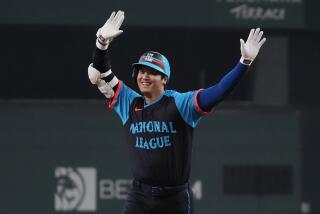Annnnd They’re Out!
- Share via
They are one of baseball’s oldest traditions, predating Babe Ruth, the ceremonial first pitch, even “Take Me Out to the Ball Game.”
So what happened to stirrup stockings?
Speaking for a majority of players, Cal State Fullerton catcher Brian Loyd says they’re simply no longer hip.
You remember the sleek top sock that hooked under the arch of the foot and stretched up past the calf? The part of the uniform that lent--we’re not afraid to say it--character to the game? Well, stirrups have all but disappeared. The few who do wear them often cover them up with ankle-hugging pants.
There are holdouts, of course. Dodger second baseman Delino DeShields proudly displays stirrups from foot to knee as a tribute to baseball’s past, specifically the Negro Leagues. Ozzie Guillen of the Chicago White Sox, teammate Kevin Tapani and Jim Thome of the Cleveland Indians also play in more traditional dress.
For the most part, though, college and pro players opt for either tube socks in solid colors or the so-called two-in-one socks with a stirrup-like stripe running down the ankle. Deceptive, yet effective.
According to Marc Okkonen, author of “Baseball Uniforms of the 20th Century” (Sterling, 1993), the stirrup stocking was introduced early this century as a substitute for the heavy wool knee socks of the late 1800s. Back then, stocking color gave the teams their identities, hence the names: the White Stockings, the Red Stockings, the Browns, etc. Team graphics, if used at all, were secondary.
But the early wool stockings got soggy, especially on hot summer afternoons. And road trips, Okkonen says, just plain stunk.
To save money, the teams issued players just one pair apiece. Ballpark laundry facilities and equipment handlers didn’t exist.
“They’d [travel] with a single pair of wool socks. You can imagine what that was like day after day,” Okkonen says.
So, in 1905, uniform designers came up with an alternative: Players would wear inexpensive cotton crew socks--available at any dry goods store--and over them, stirrups in the team colors.
“They were easy and quick to launder,” Okkonen says. “It was the obvious sanitary advantage.”
Soon, stirrups, along with the so-called sanitaries worn underneath, became as much a part of the game as peanuts and pennants.
But over the years, players began to complain: The stirrups were uncomfortable, they slid out of position, they took too much time to put on properly. Some said that today’s snug-fitting, high-tech athletic shoes left no room in the arch for the stirrup.
For many, the two-in-one sock is the answer.
“It’s like wearing the old kind of pantyhose versus the new kind of pantyhose,” says Seattle Mariner trainer Rick Griffin, head of the Professional Baseball Athletic Trainers Society. “The [two-in-one] just works better.”
Keith Tartar, assistant clubhouse manager for the California Angels, sees the stirrups’ demise a bit differently. “Society is getting so lazy,” he says. Players “just don’t want to take the time to put the sanitary on, then put the stirrup on over them.”
Of course, as many in the league point out, few fans can tell the difference from the stands, anyway.
Okkonen doesn’t buy it. Especially when he sees players on the same team sporting three sock styles--some with their pants to their knees, others with their pants to their ankles.
“I guess I’m a traditionalist,” Okkonen says, “but it almost seems phony what they’re doing now. A team uniform is supposed to make the team look uniform.
“It’s like with the military. If you let them do what they want with the uniform, it would be a disorganized, ragtag bunch.”
More to Read
Go beyond the scoreboard
Get the latest on L.A.'s teams in the daily Sports Report newsletter.
You may occasionally receive promotional content from the Los Angeles Times.










